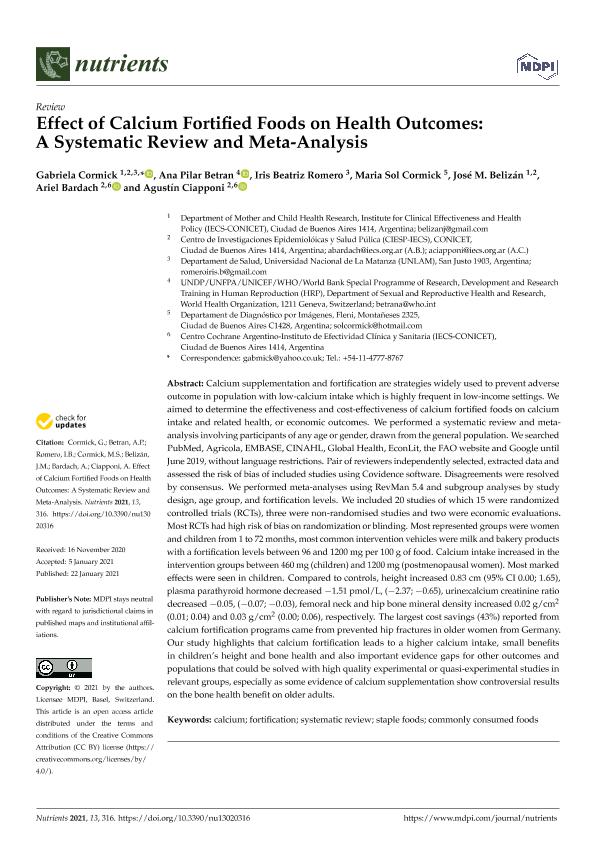Mostrar el registro sencillo del ítem
dc.contributor.author
Cormick, Gabriela

dc.contributor.author
Betrán, Ana Pilar
dc.contributor.author
Romero, Iris Beatriz

dc.contributor.author
Cormick, María Sol
dc.contributor.author
Belizan, Jose

dc.contributor.author
Bardach, Ariel Esteban

dc.contributor.author
Ciapponi, Agustín

dc.date.available
2022-10-31T11:11:54Z
dc.date.issued
2021-02
dc.identifier.citation
Cormick, Gabriela; Betrán, Ana Pilar; Romero, Iris Beatriz; Cormick, María Sol; Belizan, Jose; et al.; Effect of calcium fortified foods on health outcomes: A systematic review and meta-analysis; MDPI AG; Nutrients; 13; 2; 2-2021; 1-31
dc.identifier.issn
2072-6643
dc.identifier.uri
http://hdl.handle.net/11336/175527
dc.description.abstract
Calcium supplementation and fortification are strategies widely used to prevent adverse outcome in population with low-calcium intake which is highly frequent in low-income settings. We aimed to determine the effectiveness and cost-effectiveness of calcium fortified foods on calcium intake and related health, or economic outcomes. We performed a systematic review and metaanalysis involving participants of any age or gender, drawn from the general population. We searched PubMed, Agricola, EMBASE, CINAHL, Global Health, EconLit, the FAO website and Google until June 2019, without language restrictions. Pair of reviewers independently selected, extracted data and assessed the risk of bias of included studies using Covidence software. Disagreements were resolved by consensus. We performed meta-analyses using RevMan 5.4 and subgroup analyses by study design, age group, and fortification levels. We included 20 studies of which 15 were randomized controlled trials (RCTs), three were non-randomised studies and two were economic evaluations. Most RCTs had high risk of bias on randomization or blinding. Most represented groups were women and children from 1 to 72 months, most common intervention vehicles were milk and bakery products with a fortification levels between 96 and 1200 mg per 100 g of food. Calcium intake increased in the intervention groups between 460 mg (children) and 1200 mg (postmenopausal women). Most marked effects were seen in children. Compared to controls, height increased 0.83 cm (95% CI 0.00; 1.65), plasma parathyroid hormone decreased −1.51 pmol/L, (−2.37; −0.65), urine:calcium creatinine ratio decreased −0.05, (−0.07; −0.03), femoral neck and hip bone mineral density increased 0.02 g/cm2 (0.01; 0.04) and 0.03 g/cm2 (0.00; 0.06), respectively. The largest cost savings (43%) reported from calcium fortification programs came from prevented hip fractures in older women from Germany. Our study highlights that calcium fortification leads to a higher calcium intake, small benefits in children’s height and bone health and also important evidence gaps for other outcomes and populations that could be solved with high quality experimental or quasiexperimental studies in relevant groups, especially as some evidence of calcium supplementation show controversial results on the bone health benefit on older adults.
dc.format
application/pdf
dc.language.iso
eng
dc.publisher
MDPI AG
dc.rights
info:eu-repo/semantics/openAccess
dc.rights.uri
https://creativecommons.org/licenses/by/2.5/ar/
dc.subject
CALCIUM
dc.subject
COMMONLY CONSUMED FOODS
dc.subject
FORTIFICATION
dc.subject
STAPLE FOODS
dc.subject
SYSTEMATIC REVIEW
dc.subject.classification
Otras Ciencias de la Salud

dc.subject.classification
Ciencias de la Salud

dc.subject.classification
CIENCIAS MÉDICAS Y DE LA SALUD

dc.title
Effect of calcium fortified foods on health outcomes: A systematic review and meta-analysis
dc.type
info:eu-repo/semantics/article
dc.type
info:ar-repo/semantics/artículo
dc.type
info:eu-repo/semantics/publishedVersion
dc.date.updated
2022-09-29T13:46:49Z
dc.journal.volume
13
dc.journal.number
2
dc.journal.pagination
1-31
dc.journal.pais
Suiza

dc.journal.ciudad
Basel
dc.description.fil
Fil: Cormick, Gabriela. Universidad Nacional de La Matanza; Argentina. Consejo Nacional de Investigaciones Científicas y Técnicas. Oficina de Coordinación Administrativa Parque Centenario. Centro de Investigaciones en Epidemiología y Salud Pública. Instituto de Efectividad Clínica y Sanitaria. Centro de Investigaciones en Epidemiología y Salud Pública; Argentina
dc.description.fil
Fil: Betrán, Ana Pilar. No especifíca;
dc.description.fil
Fil: Romero, Iris Beatriz. Universidad Nacional de La Matanza; Argentina
dc.description.fil
Fil: Cormick, María Sol. Departamento de Diagnóstico Por Imágenes; Argentina
dc.description.fil
Fil: Belizan, Jose. Consejo Nacional de Investigaciones Científicas y Técnicas. Oficina de Coordinación Administrativa Parque Centenario. Centro de Investigaciones en Epidemiología y Salud Pública. Instituto de Efectividad Clínica y Sanitaria. Centro de Investigaciones en Epidemiología y Salud Pública; Argentina
dc.description.fil
Fil: Bardach, Ariel Esteban. Consejo Nacional de Investigaciones Científicas y Técnicas. Oficina de Coordinación Administrativa Parque Centenario. Centro de Investigaciones en Epidemiología y Salud Pública. Instituto de Efectividad Clínica y Sanitaria. Centro de Investigaciones en Epidemiología y Salud Pública; Argentina
dc.description.fil
Fil: Ciapponi, Agustín. Consejo Nacional de Investigaciones Científicas y Técnicas. Oficina de Coordinación Administrativa Parque Centenario. Centro de Investigaciones en Epidemiología y Salud Pública. Instituto de Efectividad Clínica y Sanitaria. Centro de Investigaciones en Epidemiología y Salud Pública; Argentina
dc.journal.title
Nutrients
dc.relation.alternativeid
info:eu-repo/semantics/altIdentifier/doi/https://doi.org/10.3390/nu13020316
Archivos asociados
